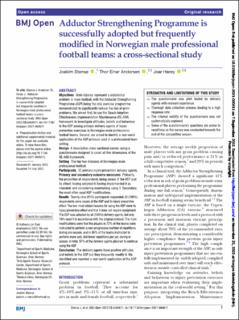| dc.contributor.author | Stensø, Joakim Schanke | |
| dc.contributor.author | Andersen, Thor Einar | |
| dc.contributor.author | Harøy, Joar | |
| dc.date.accessioned | 2022-12-01T09:48:00Z | |
| dc.date.available | 2022-12-01T09:48:00Z | |
| dc.date.created | 2022-10-21T08:50:25Z | |
| dc.date.issued | 2022 | |
| dc.identifier.citation | BMJ Open. 2022, 12(9), Artikkel e060611. | en_US |
| dc.identifier.issn | 2044-6055 | |
| dc.identifier.uri | https://hdl.handle.net/11250/3035247 | |
| dc.description | This is an open access article distributed in accordance with the Creative Commons Attribution Non Commercial (CC BY-NC 4.0) license, which permits others to distribute, remix, adapt, build upon this work non- commercially, and license their derivative works on different terms, provided the original work is properly cited, appropriate credit is given, any changes made indicated, and the use is non-commercial. | en_US |
| dc.description.abstract | Objectives: Groin injuries represent a substantial problem in male football, with the Adductor Strengthening Programme (ASP) being the only exercise programme demonstrated to significantly reduce the risk of groin problems. We aimed first, to use the Reach Adoption Effectiveness Implementation Maintenance (RE-AIM) framework to investigate attitudes, beliefs and behaviour to the ASP among primary delivery agents of injury prevention exercises in Norwegian male professional football teams. Second, we aimed to identify a real-world application of the ASP protocol used in a professional team setting.
Design: A descriptive cross-sectional survey, using a questionnaire designed to cover all five dimensions of the RE-AIM framework.
Setting: The top two divisions of Norwegian male professional football.
Participants: 32 primary injury prevention delivery agents.
Primary and secondary outcome measures: Primarily, the proportion of respondents being aware of the ASP and its effect; having adopted it; having implemented it as intended; and considering maintaining using it. Secondary, the most often used ASP modifications.
Results: Twenty-nine (91%) participants responded. All (100%) respondents were aware of the ASP and its injury preventive effect. The two most stated reasons for using the ASP were its injury preventive effect and that it does not require equipment. The ASP was adopted by all (100%) delivery agents, but only 10% used it in accordance with the original protocol. The main modifications were that the players in 72% of the teams were instructed to perform a non-progressive number of repetitions during pre-season, and in 86% of the teams instructed to perform more sets, but fewer repetitions per set, during in season. In total, 97% of the delivery agents planned to continue using the ASP.
Conclusion: The delivery agents have positive attitudes and beliefs to the ASP, but they frequently modify it. We identified and reported a real-world application of the ASP protocol. | en_US |
| dc.language.iso | eng | en_US |
| dc.subject | Adductor Strengthening Programme | en_US |
| dc.subject | ASP | en_US |
| dc.subject | football | en_US |
| dc.subject | groin injuries | en_US |
| dc.subject | injury prevention | en_US |
| dc.subject | male | en_US |
| dc.subject | Norwegian | en_US |
| dc.subject | preventive medicine | en_US |
| dc.subject | rehabilitation medicine | en_US |
| dc.subject | sports medicine | en_US |
| dc.title | Adductor Strengthening Programme is successfully adopted but frequently modified in Norwegian male professional football teams: A cross-sectional study | en_US |
| dc.type | Peer reviewed | en_US |
| dc.type | Journal article | en_US |
| dc.description.version | publishedVersion | en_US |
| dc.rights.holder | © Author(s) (or their employer(s)) 2022 | en_US |
| dc.source.pagenumber | 8 | en_US |
| dc.source.volume | 12 | en_US |
| dc.source.journal | BMJ Open | en_US |
| dc.source.issue | 9 | en_US |
| dc.identifier.doi | 10.1136/bmjopen-2021-060611 | |
| dc.identifier.cristin | 2063498 | |
| dc.description.localcode | Institutt for idrettsmedisinske fag / Department of Sports Medicine | en_US |
| dc.source.articlenumber | e060611 | en_US |
| cristin.ispublished | true | |
| cristin.fulltext | original | |
| cristin.qualitycode | 1 | |
